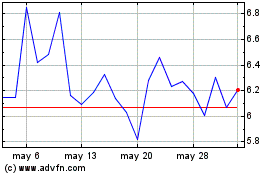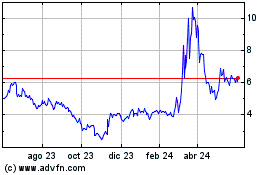- Lantern Pharma was granted the rare pediatric disease
designation (RPDD) for drug-candidate, LP-184, in three cancer
indications: Malignant Rhabdoid Tumors, Rhabdomyosarcoma, and
Hepatoblastoma.
- This brings the total number of RPDDs for LP-184 to 4,
including one previously granted for ATRT (Atypical Teratoid
Rhabdoid Tumors).
- Efficacy of LP-184 in these three rare pediatric cancers was
demonstrated through evidence of tumor regression and extended
event-free survival in specialized models developed as part of the
Pediatric Preclinical Testing Program (PPTP), an initiative
supported by the National Cancer Institute (NCI) to identify novel
therapeutic agents that may have significant activity against
childhood cancers.
- Companies with RPDDs might be eligible to receive a Priority
Review Voucher (PRV) upon FDA marketing approval that could be
redeemed to receive a priority review for any subsequent marketing
application. If received, PRVs may be used by the sponsor or sold
to another sponsor and have recently sold for over $100
million(1).
Lantern Pharma Inc. (NASDAQ: LTRN), an artificial intelligence
(“AI”) company developing targeted and transformative cancer
therapies using its proprietary RADR® AI and machine learning
(“ML”) platform with multiple clinical-stage drug programs,
announced today that the company has been granted three rare
pediatric disease designations (RPDD) by the FDA. Lantern was
granted these rare pediatric disease designations in: malignant
rhabdoid tumors (MRT), rhabdomyosarcoma (RMS), and
hepatoblastoma.
"At Lantern, we're harnessing AI and data-driven approaches to
revolutionize cancer drug development, aiming to dramatically
reduce costs, accelerate timelines, and enhance precision in
bringing new therapies to patients," stated Panna Sharma, CEO and
President of Lantern Pharma. "Our recent breakthrough in
identifying three additional, high-potential indications for LP-184
in pediatric cancers exemplifies this progress. We believe that 'AI
for good' should address both blockbuster opportunities as well as
rare, often overlooked pediatric cases. The FDA's Rare Pediatric
Disease designation for these three potential programs is a
testament to this commitment. We're acutely aware that patients and
their families are relying on innovators like us to speed up
therapy development. These designations mark a crucial step forward
in advancing our expanding portfolio of pediatric programs
targeting these devastating and rare cancers. It reinforces our
dedication to transforming hope into tangible solutions for those
who need them most."
Rare pediatric diseases are defined by the FDA as serious or
life-threatening conditions primarily affecting children under 18,
with fewer than 200,000 cases in the U.S. A key benefit of
obtaining a RPDD is the potential to receive a priority review
voucher following FDA approval of a product with RPDD if the
marketing application submitted for the product satisfies certain
conditions, including approval prior to September 30, 2026 unless
changed by legislation. These vouchers, often called "golden
tickets," can significantly expedite the review process for future
NDAs or biologic license applications, reducing the standard review
time from about ten months to six. Sponsors can either use these
vouchers themselves or sell them to other companies. These
vouchers, in the recent past, have commanded sales prices of
approximately $100 million USD.
Lantern’s investigational drug candidate, LP-184, has shown
preclinical activity in a wide range of solid tumors, garnering it
multiple orphan and rare pediatric designations. LP-184 is
currently in a multi-center Phase 1A clinical trial that is
expected to enroll approximately 50 to 60 patients across a wide
range of solid tumors. Based on the results and findings from this
clinical trial and other collaborative studies, Lantern will plan
and potentially develop future clinical trials for specific
pediatric patients in ATRT, MRT, RMS and Hepatoblastoma.
About MRT - Malignant Rhabdoid Tumors
Malignant rhabdoid tumors are rare childhood cancers that
typically affect the kidneys and soft tissues, sometimes occurring
in the brain as atypical teratoid rhabdoid tumors (ATRT). The
kidney and soft tissue variant, known as malignant rhabdoid tumor
(MRT), is most common in infants and toddlers, with an average
diagnosis age of 15 months. In the United States, only 35 to 50 new
cases of MRT are diagnosed annually. These tumors can spread to
other parts of the body. While the exact cause is unknown, research
has linked a mutation in the SMARCB1 gene to nearly all rhabdoid
tumors. This mutation can sometimes occur in a patient's normal
cells, increasing their risk of developing multiple tumors. Often,
the first sign of MRT is an abdominal lump or mass, with some
children experiencing urination difficulties or blood in the
urine.
About RMS - Rhabdomyosarcoma
Rhabdomyosarcoma is a rare cancerous tumor that develops in the
body's soft tissues, which connect, support, and surround organs
and other structures. It originates from rhabdomyoblast cells,
which form early in embryonic development, making this cancer more
prevalent in children than adults. The tumor commonly appears in
the head, neck, bladder, vagina, arms, legs, and trunk, but can
also occur in areas with minimal skeletal muscle, such as the
prostate, middle ear, or bile duct system. Despite being the most
common childhood soft-tissue sarcoma, rhabdomyosarcoma affects only
about 250-300 children annually in the United States. There are two
primary types of this cancer: embryonal rhabdomyosarcoma (ERMS),
which is more common and typically affects children under six, and
alveolar rhabdomyosarcoma (ARMS), which accounts for approximately
20 percent of cases and is more frequently found in older
children.
About Hepatoblastoma
Hepatoblastomas are the most common primary malignant liver
tumors in pediatric patients, typically occurring within the first
two years of life. These tumors are classified into two histologic
types: epithelial and mixed. While most hepatoblastomas are
sporadic, about one-third of cases are associated with genetic
conditions such as Beckwith-Weidemann syndrome, familial
adenomatous polyposis (FAP), Edward syndrome (trisomy 18),
nephroblastoma, and Down syndrome. Infants with low birth weight
are at a higher risk of developing hepatoblastoma, and there is
evidence linking the tumor to preeclampsia and parental tobacco
smoking before and during pregnancy. The most common genetic
mutation in hepatoblastoma involves the Wnt signaling pathway,
leading to the accumulation of beta-catenin, particularly in
sporadic cases. In more aggressive cases, activation of TERT (human
telomerase reverse transcriptase) and MYC signaling has been
observed. Hepatoblastoma is a rare tumor, accounting for
approximately 1% of all pediatric tumors in North America and
Europe. However, its incidence is slowly increasing globally, with
a slight predominance in males.
Please find more information at:
- Website: www.lanternpharma.com
- LinkedIn: https://www.linkedin.com/company/lanternpharma/
- X: @lanternpharma
Forward-looking Statements:
This press release contains forward-looking statements within
the meaning of Section 27A of the Securities Act of 1933, as
amended, and Section 21E of the Securities Exchange Act of 1934, as
amended. These forward-looking statements include, among other
things, statements relating to: future events or our future
financial performance; the potential advantages of our RADR®
platform in identifying drug candidates and patient populations
that are likely to respond to a drug candidate; our strategic plans
to advance the development of our drug candidates and antibody drug
conjugate (ADC) development program; estimates regarding the
development timing for our drug candidates and ADC development
program; expectations and estimates regarding clinical trial timing
and patient enrollment; our research and development efforts of our
internal drug discovery programs and the utilization of our RADR®
platform to streamline the drug development process; our intention
to leverage artificial intelligence, machine learning and genomic
data to streamline and transform the pace, risk and cost of
oncology drug discovery and development and to identify patient
populations that would likely respond to a drug candidate;
estimates regarding patient populations, potential markets and
potential market sizes; sales estimates for our drug candidates and
our plans to discover and develop drug candidates and to maximize
their commercial potential by advancing such drug candidates
ourselves or in collaboration with others. Any statements that are
not statements of historical fact (including, without limitation,
statements that use words such as "anticipate," "believe,"
"contemplate," "could," "estimate," "expect," "intend," "seek,"
"may," "might," "plan," "potential," "predict," "project,"
"target," “model,” "objective," "aim," "upcoming," "should,"
"will," "would," or the negative of these words or other similar
expressions) should be considered forward-looking statements. There
are a number of important factors that could cause our actual
results to differ materially from those indicated by the
forward-looking statements, such as (i) the risk that our research
and the research of our collaborators may not be successful, (ii)
the risk that observations in preclinical studies and early or
preliminary observations in clinical studies do not ensure that
later observations, studies and development will be consistent or
successful, (iii) the risk that we may not be successful in
satisfying the conditions necessary to receive a rare pediatric
designation priority review voucher, (iv) the risk that we may not
be successful in licensing potential candidates or in completing
potential partnerships and collaborations, (viv) the risk that none
of our product candidates has received FDA marketing approval, and
we may not be able to successfully initiate, conduct, or conclude
clinical testing for or obtain marketing approval for our product
candidates, (vi) the risk that no drug product based on our
proprietary RADR® AI platform has received FDA marketing approval
or otherwise been incorporated into a commercial product, and (vii)
those other factors set forth in the Risk Factors section in our
Annual Report on Form 10-K for the year ended December 31, 2023,
filed with the Securities and Exchange Commission on March 18,
2024. You may access our Annual Report on Form 10-K for the year
ended December 31, 2023 under the investor SEC filings tab of our
website at www.lanternpharma.com or on the SEC's website at
www.sec.gov. Given these risks and uncertainties, we can give no
assurances that our forward-looking statements will prove to be
accurate, or that any other results or events projected or
contemplated by our forward-looking statements will in fact occur,
and we caution investors not to place undue reliance on these
statements. All forward-looking statements in this press release
represent our judgment as of the date hereof, and, except as
otherwise required by law, we disclaim any obligation to update any
forward-looking statements to conform the statement to actual
results or changes in our expectations.
(1)
Recent PRV (Priority Review Vouchers) sold
and publicly disclosed in recent 12 months: Ipsen Pharma on
08/27/24 for $158 Mn; Day One Bio on
5/30/24 for $108 Mn.; X4
Pharmaceuticals on 05/09/24 for $105
Mn; Valneva SE on 02/25/24 for $103
Mn; Bluebird Bio on 10/30/23 for $103
Mn.
View source
version on businesswire.com: https://www.businesswire.com/news/home/20240923042569/en/
Investor Relations – IR@lanternpharma.com
Lantern Pharma (NASDAQ:LTRN)
Gráfica de Acción Histórica
De Dic 2024 a Ene 2025

Lantern Pharma (NASDAQ:LTRN)
Gráfica de Acción Histórica
De Ene 2024 a Ene 2025
